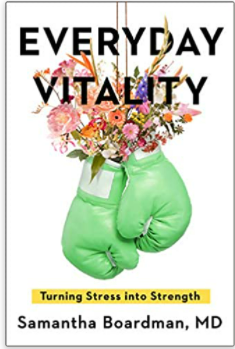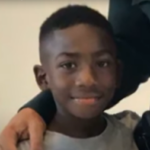






Dr. Samantha Boardman’s Secret to Becoming Less Anxious About Everything (Including Our Kids)
In her new book, Everyday Vitality, psychiatrist Samantha Boardman recalls a patient she had early in her career who walked in one day and announced:
“I hate coming to our weekly sessions. All we do is talk about the bad stuff in my life…. Even if I’m having a good day, coming here makes me think about all the negative things,” said the patient – who quit.
That shocked Boardman into wondering if maybe the patient had a point. Why DOES psychology dwell so much on the past? Why DOES it allow – encourage — patients to ruminate on worries and regrets? Why doesn’t it push patients to go out and do something new that connects them to people, or a purpose, since we know that feeling needed and competent makes people feel better?
Gradually Boardman began to suspect that the whole psychological model might have it backwards: Rather than trying to help patients to change their thoughts as the key to changing their lives, vice versa was the way to go.
Boardman’s research dovetails with Let Grow’s belief that only action – not pondering – can fight the national anxiety that has developed around giving kids some independence.
You can agree that kids need more autonomy and adventures. But until you actually let go (sometimes with the help of our Let Grow Project), you can get stuck in deep, dark “What if something horrible happens?” mode, which is paralyzing. Only by letting our kids do something new, on their own, do THEY get to spread their wings and WE get to watch them fly.
That real-world experience changes parents in a way that no mere cogitating about childhood independence could do.
Let Grow spoke with Boardman about her action-oriented outlook on how to get people doing the things that make them — and the world — a better place.
LET GROW: Everyday Vitality – what does that mean?
There are things we can do every day to have a better day, or at least a bad day backup plan.
LET GROW: Usually we hear we all have to dig deep to discover past trauma…
I kind of debunk some of these ideas that are so engrained in the way we think about mental health – the idea that “It’s all in your head” and “Drill down to the core and then the skies will part.” All of that is a deeply flawed way to think. Happiness doesn’t come from WITHIN it comes from WITH.
LET GROW: Your book makes it very clear that actions matter a whole lot more than thoughts, when it comes to a person changing.
I remember hearing Howard Stern saying therapy had changed him. He had a strained relationship with his father who was very cold and had no interest in him. He’d come into the house and his dad would say, “Shut up.” He was describing this to his therapist and then went, “OMG – that’s why I went into radio! It’s the only way to have my father listen to me!” But unless those revelations are going to actually change how you behave in the world, you can have them and still be sitting on the couch.
LET GROW: So in some ways, psychology, or at least the pop psychology we’ve absorbed into our everyday lives, stops too short. It lets us sort of stagnate and stew. It maybe even rewards self-pity. Can you tell me any instances you’ve seen of this?
At some schools they’ve trained the faculty to look for distress. It’s empowering the faculty to identify the miserable students there. You are creating this kind of wound-collecting. Look and you shall find…
LET GROW: Fragility everywhere.
So students are learning to identify as an “anxious person,” and parents are being told that their kids are already so damaged from the past two years that there’s probably no recovery. But in the past, families dealt with polio and iron lungs and your father in the war and he’s missing. The idea that this era is uniquely traumatic –
LET GROW: Is belied by the whole of human history. For starters.
Including 9/11! One of the people I worked with had been in the first tower. When the elevator opened, a fireball came in and he was burned over 90 percent of his body. I don’t know whose genius idea it was to invite him to speak to all of us [psychiatrists] five years later but he gave this wonderful grand rounds [talk] about learning to navigate a life with that kind of loss.
It is hard to believe how resilient people can be.
There’s even research that when you’re constantly asking somebody, “Are you okay?” it’s likely to make them feel less okay. I don’t want to dismiss the reality where people are suffering, but we’re living in a world where the narrative is you should feel helpless and hopeless in the face of any challenge.
What else about today’s psychological landscape would you like to see change?
The whole idea that there is this true you, this kernel of truth that defines you in every way. When you’re so identity-focused you lose the ability to connect.
The alternative is called self-expansion theory – that we wear all these different hats. It’s not, “I am where I went to college,” or, “I’m a lawyer.” Don’t limit yourself.
LET GROW: Your book is filled with suggestions on how to make change actionable, like the “WOOP” exercise, where instead of just thinking, “I’d like to make new friends,” or “start exercising,” or “feel happier,” you say the idea is to WOOP it: Wish for something, imagine the Outcome of doing it, then think of the biggest Obstacle, and Plan a way around it so you can actually get going. Why don’t we understand that the secret to a better life – and I mean this for kids as well as adults — is ACTION?
Self-absorption or self-immersion kind of protects us from having to venture out into the world and do things that go beyond ourselves. It greenlights that kind of narcissistic behavior we’re all vulnerable to. We have an excuse to fixate on ourselves and ruminate and immerse in our emotions. But to think that is going to provide a pathway out – it’s such a false promise. And it’s expensive and isolating and it takes [people] away from the very things that make them feel strong, which is other people, and feeling they’re efficacious, feeling they can contribute to something beyond themselves.
Talk to me about your flashlight metaphor.
You see the footage of trail skiers and it’s overwhelming: Oh my God, a tree! A tree! Another tree! A tree! And they’re asked about how they deal with this and they say, “I just look for the white.” And then you look at the video again and you can see it. There is that ability to search for something else.
So the white – the snow – is a path that leads away from self-recrimination and fear and out into the world? Give me a real life example. Say someone comes in and they’re distraught about something they’ve done.
To stop people from spinning their wheels I say, “What would a fly on the wall say about what just happened?” Or, “What would my future self say?” Or, “How would someone you admire react?” You’re not dwelling anymore – you’re coming up with a plan.
Just thinking is not going to get you from where you are to where you want to be. We’re told to think positively all the time, but the empty promise of being more optimistic without doing something to make things happen means you’ll end up exactly where you started. [We have to] override those impulses to withdraw or isolate.
LET GROW: So your mission is?
What I really try to do is close that intention/action gap.
LET GROW: So does Let Grow!
This interview has been edited for length and clarity.




Comments are closed for this article.